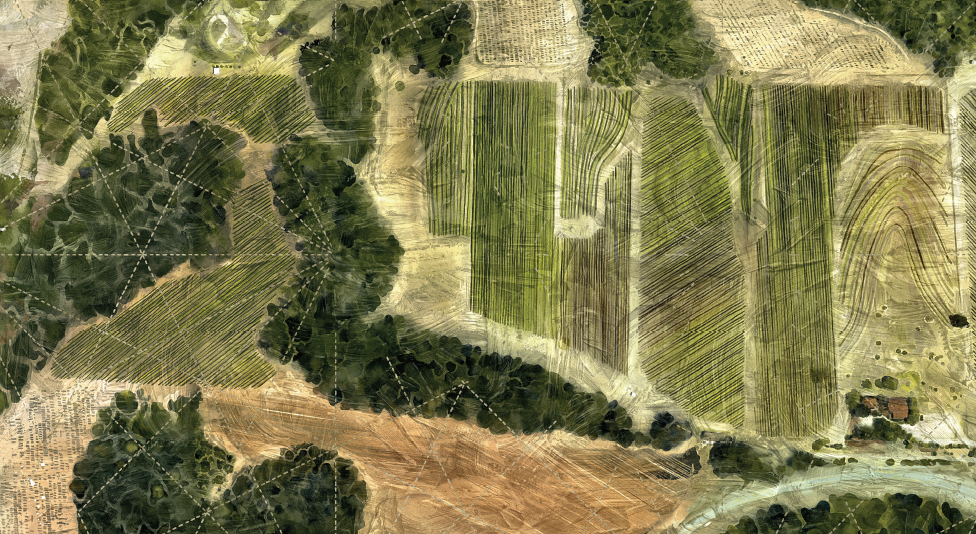THE LAND
SOIL
The two main types of soils found in our vineyard are known as GAZOS and SANTA LUCIA soils. The Gazos consists of moderately deep, well drained soils that formed in material weathered from sandstone and shale. The Santa Lucia consists of moderately deep, well drained soils that formed in material weathered from white shale containing some ash, some siliceous, and some diatomaceous material. The pH in the soils range from a low of 5.1 in the upper elevations to a high of 6.4 in the lower portions of the vineyard and is an optimal range for nutrient uptake by the vines. The lower pH soils have a greater concentration of the fractured shale and require more nutrient additions than the higher pH soils which have a greater concentration of deep clay loam and more nutrient availability for each plant. The greater number of rocks and stones at the soil surface is quite noticeable as you increase in elevation in the vineyard.
LAYOUT
The 28-acre vineyard is predominantly comprised of hillsides with south-facing slopes and steep terraced blocks. This orientation is preferable due to the maximum sun exposure for the vines. The lower vineyard blocks are at 900 feet above sea level and range to over 1,200 feet at the highest blocks. Located within the Willow Creek District AVA the vineyard faces significant swings in day and night temperatures with as much as 50°F in variation. This allows the fruit to hold onto its acidity and achieve prime phenolic maturity during the long, warm growing season.
PRACTICES
We are devoted to the natural surroundings on the 60+ acre property. Surrounded by oak forests teaming with wildlife we take an organic, sustainable approach to farming. No pesticides or herbicides are used and we use a combination of different vineyard “cocktails” to help feed the vines nutrition. Organic composts are spread in the late fall followed by a healthy cover crop being grown from the nourishment of winter rains. These cover crops do well to feed bees, insects, and all the other biodiversity on our property. It is truly a harmonious balance in the environment that leads to great wines. By late spring the cover crops are mowed down to provide much needed mulch to help feed the surface roots of each plant. We minimize our irrigation to allow for the plants to reach deep into the soils in search of water and nutrients and gives just enough for each individual plant directly into its rooting zone. We also avoid tilling to minimize our carbon impact as well as the loss of loose soils down our steep hillsides during the rainy season.
DIVERSITY
The 28-acres of vineyards are planted in 24 unique blocks to the following varieties:
| Block 1: Grenache - Clone 362 | Block 6T: Mourvedre - Clone 369 | Block 9B: Syrah - Clone 470 |
| Block 2: Primitivo - Clone 3 | Block 7A: Mourvedre - Clone 369 | Block 9C: Syrah - Clone 470 |
| Block 3: Syrah - Clone Estrella | Block 7B: Petite Sirah - Clone 3 | Block 10: Grenache - Clone 362 |
| Block 4: Syrah - Clone 174 | Block 7T: Mataro - Clone 05.1 | Block 11: Tannat - Clone 474 |
| Block 5: Syrah - Clone 877 | Block 8A: Syrah - Clone 383 | Block 12: Petit Verdot - Clone 02 |
| Block 6A: Viognier - Clone 642 | Block 8B: Syrah - Clone 383 | Block 13A: Syrah - Clone 470 |
| Block 6B: Roussanne - Clone 467 | Block 8C: Syrah - Clone 383 | Block 13B: Syrah - Clone 877 |
| Block 6C: Syrah - Clone Alban 1 | Block 9A: Tempranillo - Clone 770 | Block 13C: Syrah - Clones Alban 1, 174, 383, Estrella |
MICROCLIMATE
Our 28-acre vineyard is located in the Willow Creek AVA of Paso Robles and directly in line with what is called the “Templeton Gap.” This area is distinctly known for its large diurnal swings brought on by the cool ocean breeze that is pulled in through a gap in the ridgeline of the Santa Lucia Mountain range. Daytime temperatures from May to September can range from 75˚F up to 115˚F but in the evening drop by over 50˚F. The hot days allow for full phenolic ripeness while the cool nights allow for the vines to recover and the fruit to hold onto its natural acidity. Although generally still a warm growing region, the cooler temperatures on our property separate us from many of the other regions in the greater Paso Robles AVA. Yearly average rainfall is historically only between 15 to 20 inches per year.
